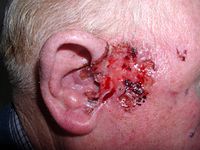
Photo from wikipedia
Samples of the liver, telencephalon, brainstem, and cerebellum were obtained from 22 bovids suffering from spontaneous or experimental acute toxic liver disease. Perreyia flavipes larvae, and leaves of Cestrum corymbosum,… Click to show full abstract
Samples of the liver, telencephalon, brainstem, and cerebellum were obtained from 22 bovids suffering from spontaneous or experimental acute toxic liver disease. Perreyia flavipes larvae, and leaves of Cestrum corymbosum, Cestrum intermedium, Dodonaea viscosa, Trema micrantha, and Xanthium cavanillesii were the causal agents in the disorders studied. Hematoxylin and eosin and periodic acid–Schiff staining, as well as anti-S100 protein (anti-S100), anti–glial fibrillary acidic protein (anti-GFAP), and anti-vimentin immunostaining were used to evaluate the brain sections. Astrocytic changes were observed in all samples and were characterized by swollen vesicular nuclei in gray (Alzheimer type II astrocytes) and white matter; and by abundant eosinophilic or vacuolated cytoplasm with pyknotic nuclei in the white matter. These changes were evidenced by anti-S100 and anti-GFAP immunostaining. Our study demonstrates major changes in astrocytes of cattle that died with neurologic clinical signs as the result of acute toxic liver disease.
Journal Title: Journal of Veterinary Diagnostic Investigation
Year Published: 2017
Link to full text (if available)
Share on Social Media: Sign Up to like & get
recommendations!